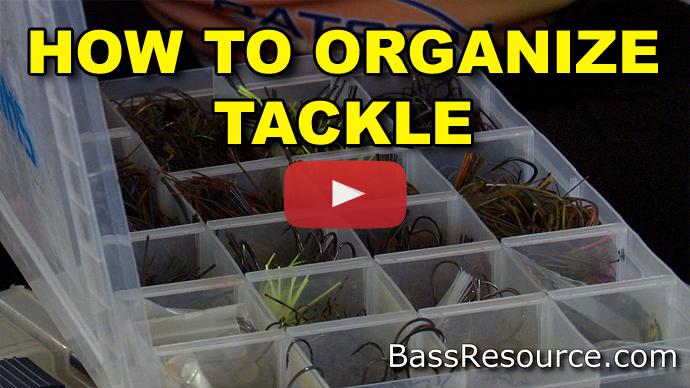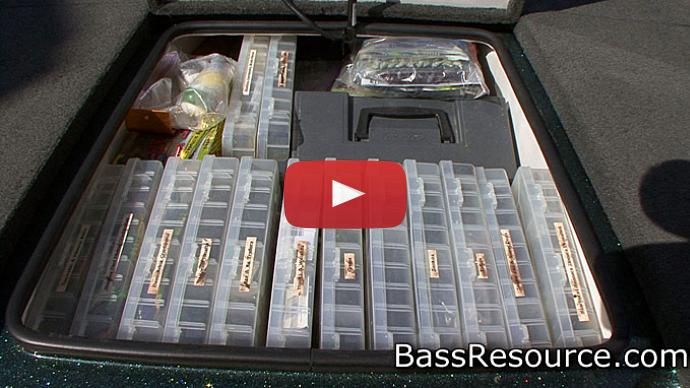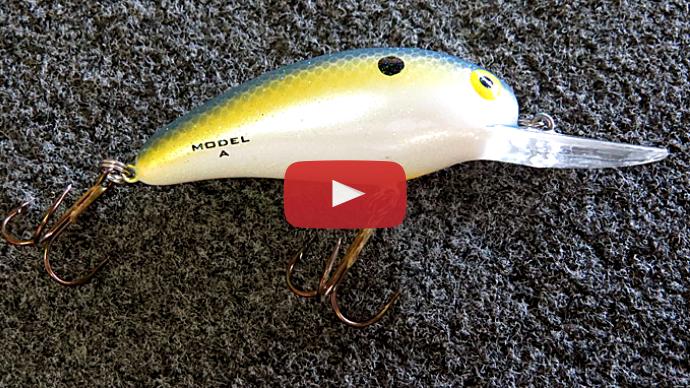Tackle organization is critical to your success. You need to be able to find everything quickly and efficiently, without having to hunt and peck and try to find everything. That's what we're talking about today.
I'm Glenn May with BassResource.com and I'm gonna take you through the way that I organize my tackle. Now, I know full well that most people... You know, tackle organization is very personal. It is dependent upon your style of fishing, what room you have or what availability you have for storage, whether you're bank fishing, whether you're someone who goes with your friends and fishes out of different boats. There's a lot of considerations that go into it that really, it depends on your unique circumstances as to how you want to organize your tackle.
That said, there's a lot to be gleaned from figuring out how, or learning how other people organize their tackle. And you can maybe incorporate some of those things into your style. So that's what I'm gonna do today. I'm just gonna show you what I do. It's not... I'm not saying it's the best way to do things, however, it may spark a few ideas for you.
So, first of all let's start off... Obviously I'm in a boat, so I don't have to worry about toting my gear all around all the time. So it's not portable, per se. In here is, you know, typical inside of a boat. All your storage. What I've got, first of all, is what's...what I need every day, every time I go fishing.
First of all, pair of pliers, in case I'm crankbait fishing and wanna pull those hooks out without hooking myself. I've got a scale. Yes, I do have it readily available because occasionally I do catch fish. But digital scale, this is a Berkeley if you guys wanna know what that is. It's a Boga grip style type of a scale. Works great. Digital scale. I've got my... This is my hook sharpener. It's actually a knife sharpener, but I use it for sharpening hooks. Have another video on how to sharpen hooks, look it up, you'll see how I use it. And then of course I've got my case here for my glasses. It's getting to the point now where it's hard for me to especially tie lures when I’m using six pound test line. Especially fluorocarbon, it's hard for me to see all that with it being real thin line, so I carry a pair of reading glasses with me when I need that.
All right, so let's get into the tackle. First of all, I have it all organized essentially from hard baits to soft baits. One side to the other. My first three are my crank baits, and specifically I've got it broken up into three different depths. So I've got my shallow running crankbaits and my topwaters right here. And those are also my jerk baits, those type of things. In the middle here, I've got my mid-running crankbaits. So it's... Now I can pull these out, let me show you. These are my...all my shallow running, my jerk baits, my topwaters, things like my Devil's Horses, Pop-R’s, things like that.
Next in the line-up are my mid-running crankbaits. These run down to about 8 to 10 feet deep. Square bills, these are round bills, all sorts of shapes and colors. I usually have them organized by style, by type. So Bomber baits, square bill baits, etc. I have them organized that way. And then finally, I have my deeper diving baits. These are the ones that go from about 12 feet deeper. Again, same sorta concept. A lot of it goes, you know, where they fit, but because they're bigger baits, you need bigger compartments. These are all my deeper diving baits.
All right, so that's how I got my crankbaits. Obviously, we don't have that many crankbaits. You don't need to...you know, you don't need that...to organize it that way, but it works for me. All right, let's go a bit deeper.
Next in the line-up, I've got... These are my Brush Hogs. Yeah. Brush Hogs, lizards, that sorta thing, ready to go. I'm gonna start putting some of these back because I'm gonna run out of room.
Next are my Senko type baits. These are the plastic stick worms. I have a whole box dedicated to that because I do fish them an awful lot.
And then right in the middle of things, are my hooks and weights. This is interesting. This is an interesting box, the way I've gone about doing this. What I wanna show you here is, first of all and foremost, what I've done is, I've... My jig heads have their own compartments, they're easy to grab. They're open. Easy for me to take stuff out because it just...you can cram more in a smaller amount of space. And this is really all about efficiency here.
The hooks, what I've done, is I've taken the hooks, I've got three different hooks here, hook compartments. One is my regular worm hooks. My next ones are my flipping hooks. And then the following one...the third one is for finesse. And what I've done further is I've got these little compartments, these little bags. These little baggies that I have that they...you can get at a craft store. They're little miniature baggies. And what I've done is I've taken the hooks out of the package, I've put them in the bag, and then I've just cut off a piece of the label that tells me what size it is and what kinda hook it is. The reason I do that is several.
First of all, in these Plano type boxes, you're running down the lake, you're even moving from boat to boat or bank fishing, they're...the tackle's jostling around a lot. And hooks, when they're sitting in these Plano boxes, they either like to go over the top of the barriers there and mix and mingle with their friends next door. Or sometimes they'll go up underneath, and they'll get stuck up underneath there. So that prevents all that from happening.
Secondly, and even more importantly, is when it's raining out and you have to open up your box. If you have a lotta hooks, especially ones you sharpen, and I sharpen all of mine, you've got exposed metal there that, if it gets wet, it's gonna rust right away. I burned through a lotta hooks just because they fell prone to rust until I developed this system. And using these little bags, you keep them all nice and sealed up. Doesn't matter if it's raining or not, they don't get wet.
So, perfect little way to organize it. Not only that, but now I can keep... Instead of having a compartment for each size hook, now I can fit a whole bunch of hooks into one compartment. Really easy to get at. I've got'em organized from smallest to largest. Smallest in front, largest in the back of these compartments. So, it's really easy to fix and find or find the hooks that I need.
Same thing with the weights, I've done the exact same thing. I put them in a little baggie and I have them labeled as to what they are for the exact same reason. Works great. I can get to pretty much any kinda weight, any kinda hook, it's all in one box. I've worked really hard to get that compacted into one. So, that's my terminal tackle.
And then finally we start getting into the jigs and the other plastics. Here I have my centipedes...oh excuse me, these are all worms, straight up worms. Straight tail, sickle tail, ribbon tale, etc.
My jig box. As you can see, I've got a lotta jigs. I really like my jigs. I've got my jig trailers in here. I have them organized from finesse at the top to big jigs on the bottom, all the way up to three quarter ounce jigs on the bottom. And then you can see, I mostly fish greens and browns, so I keep the most popular ones in here.
The thing to note about this, once we get into these plastics. Let me show you something real quick. Like, here's my spider jigs, for example. As you can see, the compartments aren't completely full. They're not at all. And the reason being is I don't wanna...I don't need to take everything I own out on the lake. I wanna take enough so I can have... If they're all hitting one size or color, I have enough to carry me through the day. But that's about it. I used to cram these compartments all the way full, and when I thinned out the herd, and I... It only took... Sometimes even when I get a brand new bag, it says, like, 10 items in a bag, I'll only put half of them in there. No more than five pieces of, you know, what comes in a plastic...bag full of plastics. When I did all that, I probably took about 40 pounds of plastics out of the boat.
I know, it sounded like I was hoarding a lot, and I guess I was, I didn't realize it. But once I went down to that rule of no more than five pieces or so in the box, or of each, it really lightened up the load. And it also made it a little bit easier to keep organized. So I knew when I was getting low right away and how to...when to restock it. So those are my hula grubs.
Next...right next to it are my grubs itself. Several different types of grub sizes and styles. As you can see, I'm getting more and more towards the finesse side of things now. Here are the tubes. I love fishing tubes so I have a little bit more of those than you would see with the grubs. But I've gotten little bit more on some of the more popular colors. I use...I break my own rule of no more than five because I use them a lot and I go through them quickly. So I found I need a little bit more than that on some of these popular colors that I use.
And then finally I have what I call my finesse kit. This is for drop shot and split shotting. These are my little four inch finesse worms, my little paddle tails, my, you know, the zoom worms. All sorts of little, you know, finesse jigs. These little teeny finesse jigs. This is my finesse kit.
All right, so that's that part of it. I got a few more I wanna show you. On the...excuse me.
Okay. Couple more things. I have bags. Now, most of these plastics...you can put them in Planos like that, but some plastics require them to stay in the clamshell so they retain their shape. Rage tails is one of those, so I put my Rage tails in one gallon plastic bags. I've got all my craws in one and then I've got my other miscellaneous, my brush hogs, the lizards, those sort of things in another bag. Easy to keep organized.
I have my paddle tail baits and frogs in this. Put it towards the back because I don't use those as often, especially I'm shooting this in the winter time, so I'm not gonna be using frogs that time of year.
And then finally, I've got this little trusty box that's followed me around for years and years and years. It's probably at least three decades old now. This is a spinnerbait box. Those of you who've followed me around know that I like to fish spinnerbaits a lot. So this is by Plano, I don't know they still make this or... They probably have an equivalent that's out now. But I have all my spinner baits and buzz baits all organized in there. I have them by type and then by size and color, in different rows. All right?
So that's about it. Very straightforward way of organizing your tackle. I hope I sparked a few ideas. For more tips and tricks, visit BassResource.com.



